Implantable Real-Time Oximeter To Determine Potential Strokes And Post-Traumatic Brain-Injury Complications
a real-time oximeter and potential stroke technology, applied in the field of pulse oximeters, can solve the problems of not being able to teach stroke or other brain conditions to use oximeters, the available version cannot be used to measure the oxygenation status of cerebral tissues, and the skin version cannot be used on moving patients
- Summary
- Abstract
- Description
- Claims
- Application Information
AI Technical Summary
Benefits of technology
Problems solved by technology
Method used
Image
Examples
Embodiment Construction
[0060]Preferred embodiments of the invention will now be set forth in detail with reference to the drawings, in which like reference numerals refer to like elements throughout.
[0061]FIGS. 1-6 show the first preferred embodiment, or the oximeter A design.
[0062]FIG. 1 shows the basic circuitry of the extravascular oximeter 100. The oximeter 100 includes a light emitter 102, silicone cushions 104, and a photo receiving sensor 106 configured in a cylindrical shape to surround a vessel (not shown in FIG. 1). The emitter 102 operates under the control of an emitter driver 108 to emit light at two wavelengths, e.g., in the red and infrared ranges. An output of the photo receiving sensor 106 is made incident via fiber optics onto a photo diode 110, whose output signal goes to amplification and filtering circuitry 112 and recording circuitry 114.
[0063]FIGS. 2A and 2B show the oximeter A cross section. A waterproof semicircular light emitter 102 and a light sensor 106 will be made. An outer r...
PUM
 Login to View More
Login to View More Abstract
Description
Claims
Application Information
 Login to View More
Login to View More - R&D
- Intellectual Property
- Life Sciences
- Materials
- Tech Scout
- Unparalleled Data Quality
- Higher Quality Content
- 60% Fewer Hallucinations
Browse by: Latest US Patents, China's latest patents, Technical Efficacy Thesaurus, Application Domain, Technology Topic, Popular Technical Reports.
© 2025 PatSnap. All rights reserved.Legal|Privacy policy|Modern Slavery Act Transparency Statement|Sitemap|About US| Contact US: help@patsnap.com



